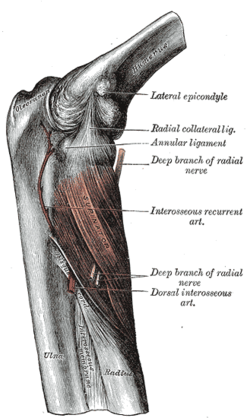| Oblique cord | |
|---|---|
 Left elbow-joint, showing anterior and ulnar collateral ligaments. (Oblique cord visible as diagonal white line near center bottom.) | |
 The supinator. (Oblique cord visible at center.) | |
| Details | |
| Identifiers | |
| Latin | chorda obliqua membranae interosseae antebrachii |
| TA98 | A03.5.06.003 |
| TA2 | 1762 |
| FMA | 39484 |
| Anatomical terminology | |
The oblique cord is a ligament between the ulnar and radius bones in the forearm near the elbow. It takes the form of a small, flattened band, extending distally and laterally, from the lateral side of the ulnar tuberosity at the base of the coronoid process to the radius a little below the radial tuberosity.[1] Its fibers run in the opposite direction to those of the Interosseous membrane of the forearm.[1]
It is called by other names including oblique ligament, chorda obliqua, radio-ulnar ligament, chorda oblique antebrachii anterior, proximal interosseous band, dorsal oblique accessory cord, proximal band of the interosseous membrane, superior oblique ligament, oblique ligament proper, round ligament, and ligament of Weitbrecht.[2]
It has no known function and can be cut without apparent consequence.[2]